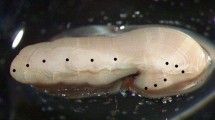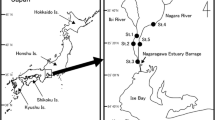Abstract
Population ecology of the troglobitic armored catfish, A. cryptophthalmus, from caves in São Domingos karst area of central Brazil, was studied in a two-census capture-mark-recapture study carried out during the dry season of 1999. Like many loricariids, including epigean Ancistrus catfishes from that area, A. cryptophthalmus is a typical bottom-dweller with a strong preference for rocky substrates in fast-flowing stream sectors. Relatively high population densities, when compared to other cavefishes, were recorded in the studied cave sections: 0.9 individuals m−2 in Angélica Cave and 0.5 individuals m−2 in Passa Três Cave. Passa Três Stream is a small tributary of the São Vicente Cave system, and the estimated population for Passa Três Cave (ca. 2000 m long) is around 1000 individuals. On the other hand, the large Angélica Cave Stream (∼8 km long) harbors a very large population, conservatively estimated at 20 000 individuals. No fish movements of distances longer than 100 m were recorded in the 40-day period. In Passa Três Cave, a few movements of distances up to 60 m were detected. Proportion of mature females in Angélica Cave was higher than in Passa Três Cave, possibly reflecting a greater food availability in the first cave. Mean individual growth rates in Angélica Cave (1.35 mm month−1 for size class <41 mm SL, 0.17 mm month−1 for size class >41 mm SL) point to relatively high longevities, possibly attaining 15 years.
Similar content being viewed by others
References
Balon, E. 1988. Tao of life: universality of dichotomyin biology. 1. The mystic awareness. Rivista di Biologia/Biology Forum 81: 185–230.
Balon, E. 1990. Epigenesis of an epigeneticist: thedevelopment of some alternative concepts on the early ontogeny and evolution of fishes. Guelph Ichthyol. Rev. 1: 1–42.
Begon, M. 1979. Estimatinganimal abundance, Edward Arnold, London. 97 pp.
Blower, J.G.,L.M. Cook & J.A. Bishop. 1981. Estimating the size of animal populations. George Allen & Unwin, London. 128 pp.
Ford, D.C. & P.W. Williams. 1989. Karst geomorphology and hydrology. Unwin Hyman, London. 601 pp.
Mattheus, W.J. 1998. Patterns in freshwater fishecology. Chapman & Hall, New York. 756 pp.
Mendes, L.F. 1995.Observations on the ecology and behavior of a new species of troglobitic catfish from northeastern Brazil (Siluriformes, Pimelodidae). Mém. Biospéol. 22: 99–101.
Nimer, E. 1989. Climatologia do Brasil,IBGE, Rio de Janeiro. 421 pp.
Reis, R.E. 1987. Ancistruscryptophthalmus sp. n., a blind mailed catfish from the Tocantins River basin, Brazil (Pisces, Siluriformes, Loricariidae). Rev. fr. Aquariol. 14: 81–84.
Trajano, E. 1991a. Populational ecology of Pimelodella kronei, troglobiticcatfish from southeastern Brazil (Siluriformes, Pimelodidae). Env. Biol. Fish. 30: 407–421.
Trajano, E. 1991b. Agonistic behavior of Pimelodellakronei, a troglobitic catfish from southeastern Brazil (Siluriformes, Pimelodidae). Behav. Processes 23: 113–124.
Trajano, E. 1997a. Synopsis ofBrazilian troglomorphic fishes. Mém. Biospéol. 24: 119–126.
Trajano, E. 1997b. Population ecology of Trichomycterusitacarambiensis, a cave catfish from eastern Brazil (Siluriformes, Trichomycteridae). Env. Biol. Fish. 50: 357–369.
Trajano, E. 1997c. Food andreproduction of Trichomycterus itacarambiensis, cave catfish from south-eastern Brazil. J. Fish Biol. 51: 53–63.
Trajano, E. 2001. Ecology ofsubterranean fishes: an overview. Env. Biol. Fish. 62: 00–00 (this volume).
Trajano, E. & F.A. Bockmann. 2000. Ecology and behavior of a newcave catfish of the genus Taunayia from northeastern Brazil (Siluriformes, Heptapterinae). Ichthyol. Explor. Freshwaters 11: 207–216.
Trajano, E. & L.E Sanchez. 1994. Brésil. pp. 527–540. In: C. Juberthie & V. Decu (ed.) Encyclopaedia Biospeologica, Société de Biospéologie, Moulis.
Trajano, E. & A.M. Souza. 1994. The behavior of Ancistrus cryptophthalmus, an armored blind catfish from caves of Central Brazil, with notes on syntopic Trichomycterus sp. (Siluriformes, Loricariidae, Trichomycteridae). Mém. Biospéol. 21: 151–159.
Author information
Authors and Affiliations
Rights and permissions
About this article
Cite this article
Trajano, E. Habitat and Population Data of Troglobitic Armored Cave Catfish, Ancistrus Cryptophthalmus Reis, 1987, from Central Brazil (Siluriformes: Loricariidae). Environmental Biology of Fishes 62, 195–200 (2001). https://doi.org/10.1023/A:1011884829498
Issue Date:
DOI: https://doi.org/10.1023/A:1011884829498




